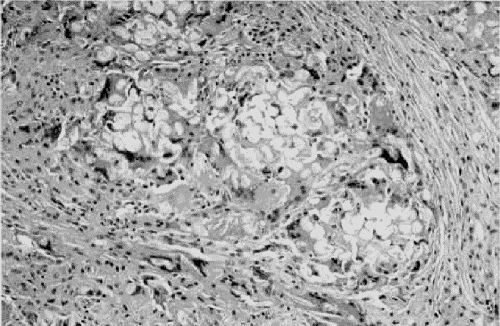The reported frequency of accidentally forgotten foreign bodies in surgery varies between 1 in 1000 and 1 in 10 000 interventions.1 The real incidence of retained gauze is hard to determine because of difficulty in obtaining an accurate figure for the occurrence of new cases. Moreover, most patients with retained intra-abdominal gauze may remain asymptomatic, and its presence may be discovered incidentally after many years.2 We report such a case of a textiloma that was found many years after the initial causative procedure.
Case report
A 58-year-old man had a 1.5-year history of swelling and tethering in the lower third of his left leg. His medical history included a right inguinal hernia repaired 15 years previously, stripping of varicose veins of his left leg 8 years after that and gout and hypercholesterolemia. On admission to our orthopedic centre his general condition was good, he had a normal gait without a limp and there was slight edema of his left ankle and distal third of the ipsilateral calf with the presence of orcein dermatitis. A 6 х 4-cm hard, indolent mass was palpable in the anterointernal side of the distal third of the leg. This mass was adherent to subcutaneous tissues, though unattached to deep tissue. A small surgical scar (5 mm) from the varicose vein operation, appeared centred on the mass. Results of the rest of the physical examination and laboratory investigation were normal. A plain x-ray film of the left lower extremity and ankle joint highlighting soft tissue showed a noncalcified tumefaction of the soft tissue with normal bone structure.
Ultrasonography revealed the presence of a soft-tissue solid, high echogenic mass, 2 cm wide and 10 cm thick. This mass appeared to be surrounded by multiple blood vessels. MRI (Fig. 1) confirmed the presence of a spindled-shaped mass measuring 2 х 6 х15 cm, well surrounded in depth by fatty subcutaneous tissue. There was a hyposignal on T 1-weighted and hypersignal on T 2-weighted images with respect to the surrounding fatty tissue, with a small white nucleus, which seemed to have central necrosis. The mass appeared to be fibrous in nature. After intravenous injection of gadolinium, the mass enhanced and showed a strong vascularization with large draining veins. The provisional diagnosis was a tumour of mesenchymal origin.

FIG. 1. MRI of the lower left leg shows a spindled-shaped mass, 2 cm wide, 6 cm long and 15 cm thick, surrounded by fatty subcutaneous tissue.
At operation, an old surgical gauze was found. Histologic examination revealed a large foreign-body granuloma (Fig. 2). There was no sign of malignancy.

FIG. 2. Histologic section showing a large foreign-body granuloma.
Discussion
The clinical presentation of textiloma may be acute or relatively delayed. The exudative form usually presents with earlier clinical manifestations because of the possibility of secondary superinfection resulting in sepsis or because of the formation of a fistula. The delayed forms are tumoral and generally appear after about 2 years but may remain latent for many years. Textiloma represents a complication of all forms of surgery: abdominal (52%), gynecologic (22%), urologic and vascular (10%), and orthopedic and spinal (6%).
The best approach to textiloma is prevention, which avoids reoperation. The principal preventive measure is to count the pieces of surgical gauze. A discrepancy in the gauze count was documented in 30 (76%) in a recent series of 40 cases of textiloma, only 2 of which were in a musculoskeletal area.3
It is interesting that emergency operations are implicated in only 30% of cases of textiloma, whereas 70% appear after elective operations.4 Although no fatal complications in a musculoskeletal site have been reported, the diagnosis is difficult and costly.
Depending on the clinical presentation, a differential diagnosis of focal myositis or infection should be considered in cases of possible tumoral or pseudotumoral lesions.
Competing interests: None declared.
Correspondence to: Dr. Elyazid Mouhsine, Department of Orthopaedic Surgery and Traumatology, University Hospital (CHUV), OTR-BH 14, Rue du Bugnon 46, CH 1011 Lausanne, Switzerland; fax +41 21 314 29 74; elyazid.mouhsine@hosr.hospvd.ch
Accepted for publication Mar. 9, 2005.
References
- 1.Grieten M, Van Poppel H, Baert L, Baert AL, Oyen R. Renal pseudotumor due to a retained perirenal sponge: CT features. J Comput Assist Tomogr 1992;16:305-7. [DOI] [PubMed]
- 2.Cowin DJ, Powell GJ, Spanier SS, Makley JT, Scarborough MT. Thigh mass in a 73-year-old man. Clin Orthop 1999;366:282-5,288-90. [DOI] [PubMed]
- 3.Salzano A, De Rosa A, Borruso G, Giordano G, Gatta G. A case of gossypiboma of the knee. Its computed tomographic diagnosis. Radiol Med (Torino) 2000;99:188-9. [PubMed]
- 4.Le Neel JC, De Cussac JB, Dupas B, Letessier E, Borde L, Eloufir M, et al. [Textilomes. A propos de 25 cas et revue de litterature.] Chirurgie 1994-95;120:272-7. [PubMed]


